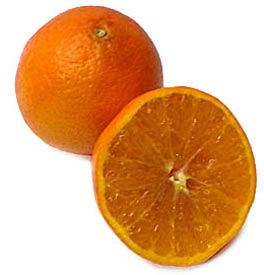Daisy Tangerines: Flavors, Benefits, and Varieties
- By The FruitGuys
- Reading Time: 4 mins.

Daisy tangerines (also sometimes called Daisy mandarins) offer a burst of vibrant flavor and are known in the citrus world for their juicy sweetness and hint of tartness.
The Daisy tangerine’s bright color, easy-to-peel skin, and nutritional profile set it apart, making it a favorite among citrus lovers.
The Origins of Daisy Tangerines
The Daisy tangerine is a cross between two mandarin oranges: The Fortune mandarin and the Fremont mandarin. It might seem strange that two mandarin parents could create a tangerine child, but in fact, tangerines are just a subcategory of mandarin. You can identify them by looking for their thin, bright-orange skin, sweet-tart taste, and slightly larger size.
The Daisy original hails from Young’s Nursery in Thermal, California. There, farmer Dowlin Young crossed the Fortune and the Fremont. His wife, Daisy Young, liked the results so much that he named the fruit after her. The Daisy tangerine hit the market in 1988 and citrus fans have enjoyed it ever since.
Nutritional Benefits of Daisy Tangerines
Like other mandarin orange varieties, Daisy tangerines are full of nutrients and fiber. Eating them can help boost your immune system, digestion, and skin health. Here is a quick look at the benefits they offer.
Rich in Vitamin C:
A Daisy tangerine of medium size is packed with enough vitamin C that is 26% of the Daily Value, which is essential for strengthening the immune system and fighting off common colds and infections. Vitamin C also plays a vital role in skin health, promoting the production of collagen which helps keep the skin looking youthful and radiant. Just four Daisy tangerines or other mandarins will provide all of the daily vitamin C that you need.
High in Dietary Fiber:
Daisy tangerines and other mandarins have a good amount of fiber (around 2 grams per fruit), which aids in digestion, helps maintain a healthy gut, and reduces the risk of obesity and disease.
Loaded with Antioxidants:
Antioxidants like flavonoids help protect your body from oxidative stress and free radicals, supporting overall health and wellness.
Taste Profile of Daisy Tangerines
Daisy tangerines boast a sweet flavor with a perfectly balanced hint of tartness, making them exceptionally refreshing. The texture of Daisy Tangerines is notably juicy and tender, with a loose peel that’s easy to separate from the flesh, enhancing their appeal as a convenient, delicious snack. Just watch out for the seeds, which can be more prevalent in Daisy tangerines than in other mandarins.
How to Choose the Best Daisy Tangerines
When selecting Daisy tangerines, look for fruits that are firm, yet slightly yielding to gentle pressure. Avoid tangerines with soft spots or overly wrinkled skin. If you want a particularly juicy fruit, look for one that feels heavy for its size For the best flavor and freshness, consider purchasing Daisy tangerines during the winter months when they’re in season.
Seasonal fruits are at their peak in ripeness, flavor, and nutrition, providing the most enjoyable eating experience. Look for locally grown tangerines as well if whenever possible. Buying from trusted sources like The FruitGuys or your local farmer’s market can ensure that you’re getting the highest quality Daisy tangerines available.
Culinary Uses of Daisy Tangerines
Daisy tangerines can add a burst of citrus to almost any dish. Try them in a refreshing salad with mixed greens and feta cheese, or create a tangy glaze for chicken by simmering tangerine juice with honey and soy sauce. For a zesty salsa, mix diced tangerines with tomatoes, onion, and cilantro. And don’t forget a light and refreshing tangerine sorbet for dessert.
You can also use the peel of your Daisy tangerines for cooking. Their tangy zest complements seafood and poultry dishes. Experiment with different ways to enjoy Daisy tangerines in your home or office kitchen.
Storage of Daisy Tangerines
To keep Daisy tangerines fresh and flavorful, store them at room temperature for up to a week. Place them in the refrigerator in a breathable container or paper bag for longer storage to prevent moisture buildup.
FAQs
Q1. Can you eat the peel of Daisy tangerines?
Yes, the peel is edible and often used in recipes for its zest, but most people prefer to eat the juicy flesh instead.
Q2. Do Daisy tangerines interact with medications?
Some citrus fruits, including grapefruits, Seville oranges, pomelos, and tangelos, can interact with medications. While there isn’t conclusive evidence that Daisy tangerines have this effect, you may still want to check with your doctor before enjoying them if you’re on medication, especially medication that breaks down in the liver.
Q3. Can Daisy tangerines be eaten daily?
Yes, they’re a healthy addition to your daily diet, offering a good source of vitamins and hydration.


